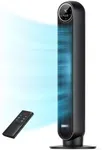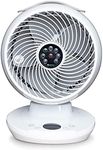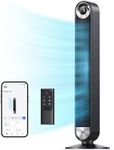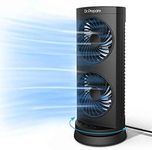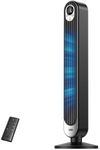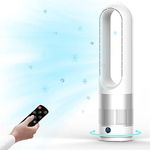Buying Guide for the Best Cooling Fan For Room
Choosing the right cooling fan for your room can significantly enhance your comfort during warm weather. The key is to understand the different features and specifications that fans offer, and how these align with your specific needs. Whether you're looking for a fan to cool a small bedroom or a large living area, knowing what to look for will help you make an informed decision.Fan TypeFans come in various types, including tower fans, pedestal fans, box fans, and desk fans. The type of fan you choose will depend on the space you have and the level of airflow you need. Tower fans are great for saving space and providing a wide range of airflow, making them suitable for medium to large rooms. Pedestal fans offer adjustable height and are ideal for larger spaces where you need to direct airflow at a specific height. Box fans are versatile and can be placed on the floor or in a window, suitable for medium-sized rooms. Desk fans are compact and best for personal use in small spaces.
Airflow CapacityAirflow capacity, often measured in cubic feet per minute (CFM), indicates how much air a fan can move. This is crucial for determining how effectively a fan can cool a room. For small rooms, a fan with a lower CFM (around 100-300) may suffice. Medium rooms might require a fan with a CFM of 300-500, while large rooms or spaces with high ceilings may need a fan with a CFM of 500 or more. Consider the size of your room and how much cooling power you need when choosing the airflow capacity.
Noise LevelThe noise level of a fan is an important consideration, especially if you plan to use it in a bedroom or office. Noise levels are measured in decibels (dB). Fans with a noise level of 50 dB or lower are generally considered quiet and suitable for bedrooms or workspaces. If noise is not a major concern, you might opt for a fan with a higher noise level, which might offer more powerful airflow. Consider where you will use the fan and how sensitive you are to noise when making your choice.
OscillationOscillation refers to a fan's ability to rotate and distribute air across a wider area. This feature is important if you want to cool an entire room rather than a specific spot. Fans with oscillation can cover more space and provide more even cooling. If you need to cool a large room or multiple people, look for a fan with a wide oscillation range. For personal use or smaller spaces, oscillation might not be as critical.
Speed SettingsMost fans come with multiple speed settings, allowing you to adjust the airflow to your preference. This is important for customizing your comfort level and energy usage. Fans with at least three speed settings (low, medium, high) offer flexibility for different cooling needs. If you want more control over the airflow, look for fans with additional speed settings or variable speed control. Consider how much control you want over the fan's performance when selecting speed settings.
Energy EfficiencyEnergy efficiency is a key consideration if you plan to use the fan frequently or for extended periods. Energy-efficient fans consume less power, which can save you money on electricity bills. Look for fans with an Energy Star rating or those that specifically mention energy-saving features. If you're environmentally conscious or want to reduce energy costs, prioritize energy-efficient models. Consider how often and how long you will use the fan to determine the importance of energy efficiency for you.
Remote ControlA remote control can add convenience by allowing you to adjust the fan's settings from a distance. This is particularly useful for fans placed in hard-to-reach areas or if you want to change settings without getting up. If convenience and ease of use are important to you, look for fans that come with a remote control. For those who prefer manual control or have the fan within easy reach, a remote may not be necessary.

